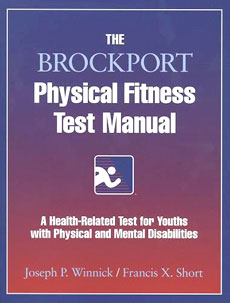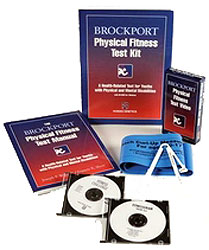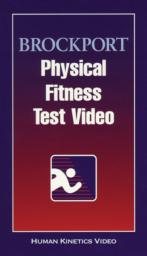The Brockport Physical Fitness Test (BPFT) is a criterion-referenced health-related test of physical fitness, appropriate for use with young people with disabilities.
History: Project Target
In 1993 the U.S. Department of Education funded some research which was named Project Target, a study designed primarily to develop a health-related and criterion-referenced physical fitness test protocol for youngsters with disabilities. The age group the study was based around was between 10 and 17 years of age. In total 1,542 youngsters with and without disabilities were tested, and the analysis of these results lead to the creation of the Brockport Physical Fitness Test. The name is derived from the project being centered at the State University of New York, College at Brockport.
Target Group
The Brockport Physical Fitness Test is designed for and is suitable for use with both able-bodied youngsters and those with disabilities such as:
- Mental retardation
- Spinal cord injuries
- Cerebral palsy
- Blindness
- Congenital anomalies
- Amputations
 Tests
Tests
The physical fitness test battery is able to be customized for nearly any student. The total number of test items available is 27, with a mix of traditional fitness tests and tests specifically modified for youngsters with disabilities (see list below). Although there are many tests to choose from, the manual guides the assessor using a five-step process to which tests are suitable, and most test batteries for individuals will involve only four to six items.
Musculoskeletal Functioning, Muscular Strength/Endurance
- Trunk Lift — while lying face down, lift the upper body off the floor as high as you can using the muscles of the back.
- Grip Strength — a measure of hand and arm strength, using the dominant hand to grip a dynamometer with as much force as possible.
- Bench Press — perform as many bench presses as possible using a 35lb (15.9kg) barbell.
- Isometric Push-up — hold a raised push-up position for up to 40 seconds.
- Push-up — complete as many push-ups as possible at a rate of 1 push-up every 3 seconds.
- Seated Push-up — extend the arms and raise the body out of a chair, and hold this position for as long as possible.
- Dumbbell Press — lift a 15lb (6.8kg) dumbbell as many times as possible at a specific cadence while sitting in a chair.
- Reverse Curl — a measure of hand, wrist, and arm strength. While sitting in a chair, the subject must perform one repetition of bringing a 1lb (0.5kg) dumbbell from the thigh to the flexed-arm position, holding it there for 2 seconds, then returning it to the thigh in a controlled manner.
- Push/Walk (40m) — walk or push a wheelchair at a comfortable speed for 40m, with a 5m start zone. It is not a race, participants are encouraged to travel at the speed they usually use for mobility. To pass, they must cover the 40-meter distance in less than 60 seconds while keeping the heart rate below 120 bpm (walkers) or 114 bpm (wheelchair users).
- Wheelchair Ramp Test — a test of upper-body strength and endurance, participants attempt to push their wheelchairs up a standard wheelchair ramp. The ramp must be at least 8 feet (2.4 meters) long, at a gradient of 8.3%.
- Curl-Up — complete up to 75 curl-ups at a rate of 1 every 3 seconds. The hands slide 4.5 inches along the ground for a complete repetition.
- Curl-Up (modified) — the curl-up test, though with the hands resting on the thighs rather than by the side.
- Extended-Arm Hang — hanging from an overhead bar with straight arms for up to 40 seconds.
- Flexed-Arm Hang — timing how long someone can hang with the chin above the bar.
- Pull Up — grasp an overhead bar and pull up the body so the chin raises above the bar, then return to arms fully extended position.
- Pull Up (modified) — with the body horizontal, grasp a bar set just out of reach, and pull up towards the bar.
Body Composition
- Skinfold Measures — calipers are used to measure the thickness of the skin at the triceps, subscapular, and calf measurement sites.
- Body Mass Index — calculated by taking a person's weight and dividing by their height squared
- Bioelectrical Impedance Analysis — a measure the resistance of body tissues to the flow of a small electrical signal, and from that the proportion of body fat is calculated
Aerobic Functioning
- PACER test (20m or 15m) — There is also a modified version for vision impaired children.
- Target Aerobic Movement Test — test the ability to sustain a moderate intensity of (any) physical activity by maintaining a heart rate between 70 and 85 percent of maximal predicted heart rate for 15 minutes.
- One-mile run/walk — run or walk as fast as possible over a one-mile distance
Flexibility
- Back-Saver Sit & Reach — performed with one leg bent, designed to measure the flexibility of the left and right legs separately.
- Shoulder Stretch — touch the fingertips together behind the back by reaching over the shoulder and down the back with one arm and across the back with the other arm.
- Apley Scratch Test (modified) — attempt to reach overhead with one hand and touch the top of the opposite shoulder blade.
- Thomas Test (modified) — requires the subject to sit at the very edge of a bench, then roll back onto the bench while pulling both knees to the chest. Measures hip flexibility.
- Target Stretch Test
- Elbow extension
- Forearm pronation
- Forearm supination
- Knee extension
- Shoulder abduction
- Shoulder extension
- Shoulder external rotation
- Wrist extension
Equipment Required
Only a few relatively inexpensive materials are required to administer the BPFT, such as a stopwatch, ruler, grip dynamometer, 35lb. barbell, seated push-up blocks, 1lb. weight, ramp, curl-up strip, pull-up bars, skinfold caliper, height-weight scale, sit and reach apparatus, heart-rate monitor, 15lb. dumbbell, and calibrated tapes (provided with the test kit). If these are not available, test item substitutions are often permitted. See more about the Brockport Testing products.
References
The following test resources are available, which provides therapists and educators with the information required to administer and interpret the tests.
- Winnick, J.P. & Short, F.X. (1999). The Brockport Physical Fitness Training Guide. Champaign, IL: Human Kinetics.
- Winnick, J. P. & Short, F.X. (2014). The Brockport Physical Fitness Test Manual. 2nd Ed. Champaign, IL: Human Kinetics.
 There are also videos available that provide a background on health-related information and has demonstrations of the test items, and also a computer software program to select test items, and print out results, goals, and fitness needs for individuals and groups of students. See more products.
There are also videos available that provide a background on health-related information and has demonstrations of the test items, and also a computer software program to select test items, and print out results, goals, and fitness needs for individuals and groups of students. See more products.
Product Links
- Buy The Brockport Physical Fitness Training Guide and Testing Manual, plus other items associated with the Brockport Test.
- Buy the PACER test cd — this recording provides pacing for the shuttle run portion of the test as well as cadences for the curl-up and push-up tests.
- Buy the Curl-up Measuring Strip for use with the Brockport Test (or make your own).
Related Pages
- Fitness Testing for Specific Populations
- Fitness Testing for Children


 Current Events
Current Events